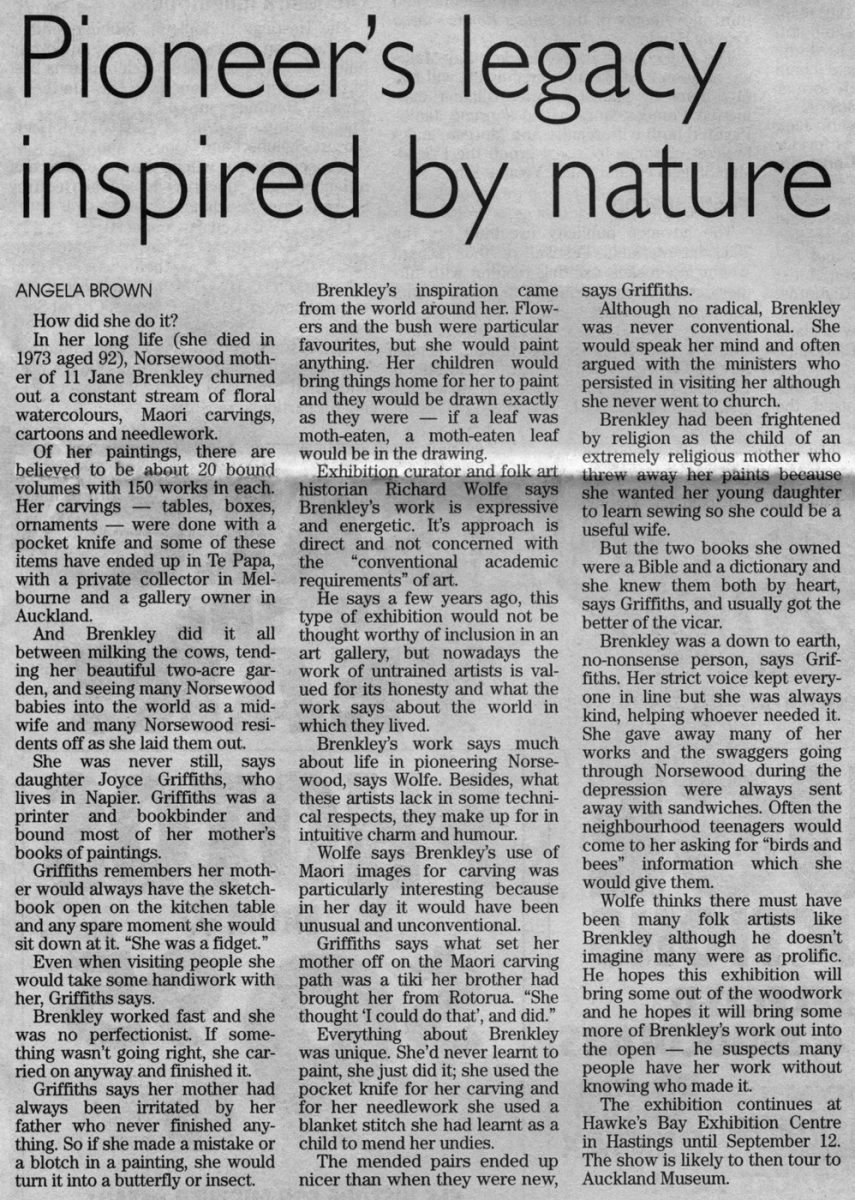Pioneer’s legacy inspired by nature
ANGELA BROWN
How did she do it?
In her long life (she died in 1973 aged 92), Norsewood mother of 11 Jane Brenkley churned out a constant stream of floral watercolours, Maori carvings, cartoons and needlework.
Of her paintings, there are believed to be about 20 bound volumes with 150 works in each. Her carvings – tables, boxes, ornaments – were done with a pocket knife and some of these items have ended up in Te Papa, with a private collector in Melbourne and a gallery owner in Auckland.
And Brenkley did it all between milking the cows, tending her beautiful two-acre garden, and seeing many Norsewood babies into the world as a midwife and many Norsewood residents off as she laid them out.
She was never still, says daughter Joyce Griffiths, who lives in Napier. Griffiths was a printer and Bookbinder and bound most of her mother’s books of paintings.
Griffiths remembers her mother would always have the sketchbook open on the kitchen table and any spare moment she would sit down at it. “She was a fidget.”
Even when visiting people she would take some handiwork with her, Griffiths says.
Brenkley worked fast and she was no perfectionist. If something wasn’t going right, she carried on anyway and finished it.
Griffiths says her mother had always been irritated by her father who never finished anything. So if she made a mistake or a blotch in a painting, she would turn it into a butterfly or insect.
Brenkley’s inspiration came from the world around her. Flowers and the bush were particular favourites, but she would paint anything. Her children would bring things home for her to paint and they would be drawn exactly as they were – if a leaf was moth-eaten, a moth-eaten leaf would be in the drawing.
Exhibition curator and folk art historian Richard Wolfe says Brenkley’s work is expressive and energetic. It’s approach is direct and not concerned with the “conventional academic requirements” of art.
He says a few years ago, this type of exhibition would not be thought worthy of inclusion in an art gallery, but nowadays the work of untrained artists is valued for its honesty and what the work says about the world in which they lived.
Brenkley’s work says much about life in pioneering Norsewood, says Wolfe. Besides, what these artists lack in some technical respects, they make up for in intuitive charm and humour.
Wolfe says Brenkley’s use of Maori images for carving was particularly interesting because in her day it would have been unusual and unconventional.
Griffiths says what set her mother off on the Maori carving path was a tiki her brother had brought her from Rotorua. “She thought ‘I could do that’, and did.”
Everything about Brenkley was unique. She’d never learnt to paint, she just did it; she used the pocket knife for her carving and for her needlework she used a blanket stitch she had learnt as a child to mend her undies.
The mended pairs ended up nicer than when they were new, says Griffiths.
Although no radical, Brenkley was never conventional. She would speak her mind and often argued with the ministers who persisted in visiting her although she never went to church.
Brenkley had been frightened by religion as the child of an extremely religious mother who threw away her paints because she wanted her young daughter to learn sewing so she could be a useful wife.
But the two books she owned were a Bible and a dictionary and she knew them both by heart, says Griffiths, and usually got the better of the vicar.
Brenkley was a down to earth, no-nonsense person says Griffiths. Her strict voice kept everyone in line but she was always kind, helping whoever needed it. She gave away many of her works and the swaggers going through Norsewood during the depression were always sent away with sandwiches. Often the neighbourhood teenagers would come to her asking for “birds and bees” information which she would give them.
Wolfe thinks there must have been many folk artists like Brenkley although he doesn’t imagine many were as prolific. He hopes this exhibition will bring some out of the woodwork and he hopes it will bring some more of Brenkley’s work out into the open – he suspects many people have her work without knowing who made it.
The exhibition continues at Hawke’s Bay Exhibition Centre in Hastings until September 12. The show is likely to then tour to Auckland Museum.












Do you know something about this record?
Please note we cannot verify the accuracy of any information posted by the community.